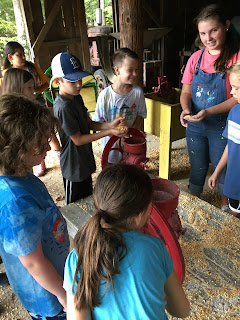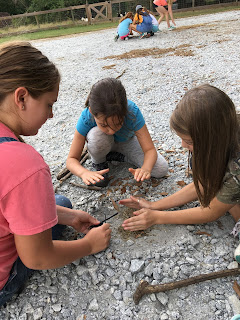Today was a bit different than our typical day. After each group completed their animal care tasks, we washed hands and jumped on a hay ride! Mr. Rick from Minter's Farm picked us up and hauled us the 1/2 mile down the road to Minter's Farm. Each year, the Minters, along with the help of some amazing friends and family, manages to host Inman Farm Heritage Days. The festivities went on all weekend, but Rick graciously allowed me to bring the kids down for a private tour! I demonstrated the apple cider press, and the class was able to drop in apples and see them pressed into cider. We squeezed sorghum, as well! I had no mule or horse... or even a tractor... so the kids stepped up and ran the cane press themselves. We collected the liquid, and I explained how the syrup was made right there all weekend long! We toured the weaving room, and the kids were able to see a mop-making machine. The wooden handle was held in place and a foot pedal controlled the spinning. The mop yarn was help in place by wire, dispensed at the back of the machine. The class was also able to see an authentic antique loom! We toured the grounds for a while before heading back up to our farm. It was an absolute JOY to see these kids down there experiencing a bit of the past!
Once back, the kids shared their Farm Fusion stories. These were awesome! Last week we learned about molting. Chickens usually start to molt once the days get shorter... and my flocks have been in the process. There are feathers EVERYWHERE! The class could either write about the molting process from the chicken's perspective or write a story or poem that involves fall on a farm. My goal with these writing assignments is to give them a positive experience with writing! They love to share these with their friends and hear each others' thoughts and ideas. The creativity is just amazing! I use these as a starting point for pointing out wonderful adjectives, for applauding transition words, and for teaching writing skills in a low-stress and conversational manner.
In the afternoon, we talked about what is going on in My Side of the Mountain. They added a map of the Catskills Mountains to add to their field guides. These field guides are growing each week, and we will add to them as we move from book to book. I was excited to see that students added illustrations, printed and pasted pictures, wrote descriptions, and just started to get into it! I am going to be encouraging peer collaboration every week. The class will be able to break into groups and discuss things they added to their Field Guides. I will even have different resources right there in the room so that the groups can dive deeper and learn more information to add! My goal with this is to try to loosen things up a bit, create a positive atmosphere, and use the excitement of peers to give these kids that spark for learning! After exploring our field guides, the class split into groups for a vocabulary matching activity. I included two weeks worth of words in the sorting activity, and the class did a great job with them! I can tell that they are working on the words at home. Keep up the good work! At home, they will be working on a fish hook project. We will show these off in class and add them to our journals.
In our book, Sam learned how to make fire from flint and steel. We headed out onto the driveway to give this a try, ourselves! The class used what they learned from the reading to catch the sparks and light their tinder. They were able to get some smoke and a little glow before the rain came!
Next, the class reviewed continents and oceans. At home, they watched a silly video that helped them to remember the names and locations of the continents. It worked like a charm. They did great! Now that we had an overview of maps, globes, latitude, longitude, the equator, prime meridian, time zones, etc., we will begin zeroing in on the different continents. We will be using a geographical approach to the countries that are grouped with the continents. For example, some people associate Greenland with Europe, while others group it with North America due to location. We'll be keeping things simple and going strictly on location. But, I wanted to explain to the students why they may find discrepancies along the way. We'll now be zeroing in on North America!
In science, we reviewed what they have learned so far. The class then began creating their interactive notebooks. They have been learning about the Classification of Living Things as created by Carolus Linnaeus. We added their at-home assignment to the notebook, and they will be working on a Taxonomy activity at home that we will include next week. Although it will take a few weeks to get past the overview period, we will be diving into each of the kingdoms of life soon!















































No comments:
Post a Comment